April 2023
By Ela Joshi
Reclassification is a term used in schools to describe when an EL student meets the required criteria to demonstrate proficiency in English. After being reclassified, a student is no longer classified as an English learner student.
Reclassification from English learner to English proficient is a crucial outcome for English learner (EL) students’ academic progress because it can open the door to more rigorous courses and lead to stronger academic outcomes.1,2 ELs spend much of their academic time with general education teachers, so it is important to understand more about the role these teachers play in developing ELs’ English language proficiency. In a recently published study, I use a Tennessee dataset to estimate the relationship between ELs’ likelihood of reclassification and characteristics of their general education English language arts (ELA) teachers in grades 3-8.3
Terminology is evolving to become more asset-based and student-centered. Increasingly, the field is using terms such as “multilingual learner” (ML) and “teaching English to speakers of other languages” (TESOL) to center students’ bilingualism. Terms such as “English learner” and “English as a Second Language” (ESL) are considered deficit based, since they focus on students’ lack of proficiency in English rather than their proficiency in other languages. However, to accurately depict the data, policies, and testing assessed in the study, I use the terms “EL” and “ESL”. I encourage the use of more asset-based language and framing for students and their teachers in both research, policy, and practice as the field continues to evolve.
Effective teachers are more successful with ELs’ in terms of their likelihood of reclassification
After accounting for student, teacher, and peer characteristics, as well as ELs’ reading proficiency, I found that several measures of teacher effectiveness consistently predicted ELs’ likelihood of reclassification.4 Even when making a conservative estimate, compared to ELs with less effective teachers based on teachers’ value-added scores, ELs assigned to effective or highly effective teachers were 15 to 25 percent more likely to be reclassified. As shown in Figure 1, the cumulative likelihood of reclassification for ELs assigned to teachers with different value-added scores grew from 3rd through 5th grade, but tapered off in middle grades, in alignment with prior research.5 These patterns were consistent across all measures of teacher effectiveness that I examined.
Figure 1. Fitted cumulative likelihood of reclassification, by teacher effectiveness (using teacher value-added scores)

Note: Figure displays the fitted cumulative likelihood of reclassification for ELs in each year following third grade (for instance, on the x-axis, 0 is third grade, and 1 is fourth grade) for statistical models predicting ELs’ likelihood of reclassification using teachers’ three-year compositive value-added level scores from the prior year (TVAAS). The state creates TVAAS effectiveness levels ranging from 1 to 5. Using teachers’ prior-year value-added (TVAAS) levels, the analysis defines teachers in levels 1 and 2 as ‘‘less effective,’’ teachers in Level 3 as ‘‘average,’’ and teachers in Levels 4 and 5 as ‘‘highly effective.’’ For more information, see Joshi (2023).
Why might highly effective teachers better support ELs’ language proficiency such that students are more likely to be reclassified? Highly effective teachers may be more skilled at differentiating instruction with attention to the specific needs of ELs by attending to phonics, vocabulary, and culture.6
What can administrators do with this information?
For ELs who have not yet attained English proficiency by third grade, assignment to highly effective teachers in the upper elementary grades may be one lever to help students attain English proficiency and thus improve multiple academic outcomes. However, in the analysis, I observed the opposite in practice: higher performing ELs—that is, those with higher scores on the prior year state exam in reading—were more likely to be assigned to more effective teachers. This disparity in assignment of ELs to effective teachers may be addressed in at least two ways: first, through more equitable assignment practices, and second, through improved professional development for classroom teachers on how to effectively differentiate instruction and integrate various instructional strategies for ELs.
References
1 Callahan, R. M., & Shifrer, D. (2016). Equitable access for secondary English learner students: Course taking as evidence of EL program effectiveness. Educational Administration Quarterly, 52(3), 463–496. https://doi.org/10.1177/0013161X16648190
2 Johnson, A. (2020). The impact of English learner reclassification on high school reading and academic progress. Educational Evaluation and Policy Analysis, 42(1), 46–65. https://doi.org/10.3102/0162373719877197
3 For details on study methodology, see Joshi, E. (2023). Unpacking the relationship between teacher characteristics and time to English learner reclassification. American Educational Research Journal, 60(2), 1-36. https://doi.org/10.3102/00028312221144755
4 Measures of teacher effectiveness examined in the study include teacher value-added scores, teacher observation scores, and teachers’ overall level of effectiveness. For more information on study measures, see Joshi (2023).
5 Thompson, K. (2017). English learners’ time to reclassification: An analysis. Educational Policy, 31(3), 330–363. https://doi.org/10.1177/0895904815598394
6 Bunch, G. C. (2013). Pedagogical language knowledge: Preparing mainstream teachers for English learners in the new standards era. Review of Research in Education, 37(1), 298–341. https://doi.org/10.3102/0091732X12461772
Topics: Elementary English language development Middle school Research Teacher Quality
